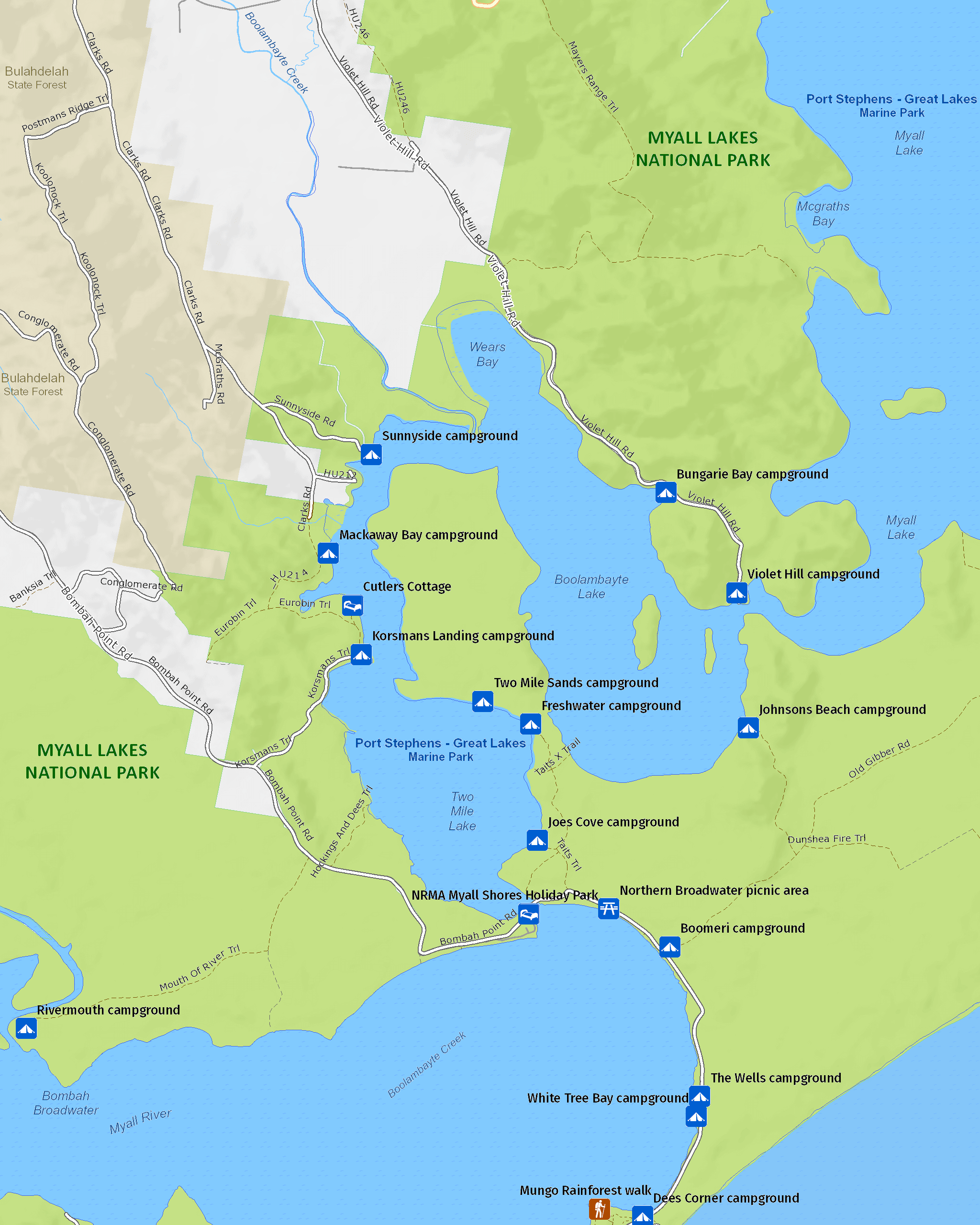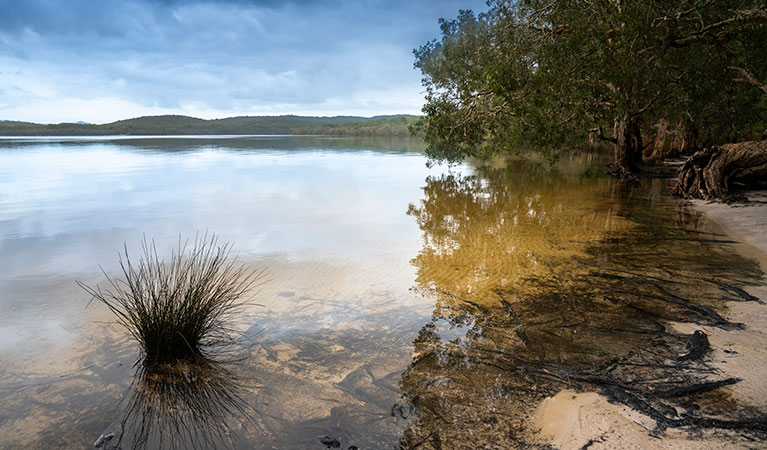Freshwater campground
Myall Lakes National Park
Overview
For boat-based camping near Nelson Bay, Freshwater campground is a secluded camping spot in Myall Lakes National Park. You can get there by boat or by walking along a 2km trail.
| Number of campsites | 7 |
|---|---|
| Camping type | Tent, Remote/backpack camping |
| Facilities | Barbecue facilities, toilets |
| What to bring | Drinking water, cooking water, insect repellent, firewood |
| Entry fees |
Park entry fees apply in addition to camping fees. |
| Group bookings | Book up to 20 people or 5 sites online. For larger groups, make a group booking enquiry. |
| Please note |
|
Located between Nelson Bay and Seal Rocks, Freshwater campground offers remote bush camping with pretty views across Two Mile Lake. The shallow waters and sandy beaches make it a perfect camping holiday for families with older children or backpack campers. Spend your days exploring the nearby walking and cycling trails or enjoy swimming and boating on the lake.
Pitch your tent, light a campfire and relax with a cup of tea as the kids swim and paddle in the lake's calm waters. Paperbark trees fringe the shoreline and the twisting angophora trees offer shade.
The charm of this campground is that it’s tucked away from everything. But if you want to explore other parts of the park, hop in your boat and head to Mungo Brush campground where you can take the short stroll along Mungo Rainforest walk and stop for a barbecue lunch.
If you’ve got a few days and a bike in tow, ride some or all of the Mining Road to Old Gibber Road cycling trail. Then head back to your campsite to enjoy the stillness and beauty of the sunset over the lake.
Map

Map legend

Local alerts
For the latest updates on fires, closures and other alerts in this area, see https://www.nationalparks.nsw.gov.au/camping-and-accommodation/campgrounds/freshwater-campground/local-alerts
Bookings
- National Parks Contact Centre
- 7am to 7pm daily
- 1300 072 757 (13000 PARKS) for the cost of a local call within Australia excluding mobiles
- parks.info@environment.nsw.gov.au
Operated by
- Booti Booti Office
- Monday to Friday, 8.30am to 4.30pm. Closed public holidays.
- 02 6591 0300
- npws.manninggreatlakes@environment.nsw.gov.au
- The Ruins campground, Booti Booti National Park, 4374 The Lakes Way, Booti Booti 2428
Park info
- in Myall Lakes National Park in the North Coast region
Myall Lakes National Park is always open but may have to close at times due to poor weather or fire danger.
-
Park entry fees:
$8 per vehicle per day.
Day passes are available from a card operated pay machine at Mungo Brush campground or from the Manning Great Lakes Area Office. You can also pay for your visit via the Park’nPay app. You’ll need a Day Pass or Annual Pass when visiting the park.
Bombah Point ferry fees may also apply (cash payment only).
Buy annual pass.
Visitor info
All the practical information you need to know about Freshwater campground.
Maps and downloads
Learn more
Freshwater campground is in Myall Lakes National Park. Here are just some of the reasons why this park is special:
Ancient connections

Myall Lakes National Park is part of the Country of the Worimi Aboriginal people, who used the area's natural resources, like freshwater lakes, the ocean and native flora and fauna to live a traditional fisher-hunter-gatherer lifestyle. Much evidence of their long connection with this Country can be seen today throughout the middens in the park. The landscape of Myall Lakes includes important spiritual sites that are an important part of the identity of local Aboriginal people. Make sure you visit Dark Point Aboriginal Place while you're at visiting the park. This rocky headland has been of significance to Worimi people for at least 4000 years. The clans or nuras (family groups) within the Worimi people would gather together here for ceremonies and feasts.
- Dark Point Aboriginal Place Dark Point Aboriginal Place, in southern Myall Lakes National Park, is a culturally significant site for the Worimi people with scenic coastal views across to Broughton Island.
- Mungo walking track Mungo walking track offers a variety of Aboriginal and historic sites, diverse vegetation, and mountain biking in Myall Lakes National Park, near Hawks Nest.
Go fish

Fishing is a popular activity in Myall Lakes, with catches likely to include bream, whiting, Australian salmon, flathead and mullet. There are lots of great places in the park to throw in a line, like the beaches, lakes or rivers. Try fishing from your boat or for a relaxing day on the water you could try a spot of kayak fishing. At Myall Lakes you can also go camping, boating, swimming and canoeing. And when you’ve tried all of those, you can explore the park on foot, by 4WD or bike, stopping for a spot of bird watching or to enjoy a picnic or barbecue lunch along the way. Whatever your interests, there is bound to be something that takes your fancy.
- Mining Road to Old Gibber Road cycling trail Mining Road to Old Gibber Road cycling trail is an easy bike ride within Myall Lakes National Park. You can complete the ride in one day or take your tent to camp overnight.
- Mungo Rainforest walk Enjoy a short and easy rainforest walk with the birds in Myall Lakes National Park, not far from Buladelah. Afterwards, you can enjoy a picnic or barbecue at Mungo Brush.
Internationally recognised wetlands

Since 1999, this internationally recognised wetlands site, has been listed under the Ramsar Convention due to its diverse mosaic of near-natural wetlands, within a relatively unmodified coastal lake system. There are 18 different wetland types with extensive interconnected lake and river systems within the forested wetlands and swamps that fringe the waterways, rocky and sandy shores, and offshore islands off the coastline. This wetland site houses a complex variety of habitats with rich biodiversity, including threatened species and migratory birds protected under international agreements. The Myall Lakes wetlands also have a high cultural and social value as they occur within the traditional lands of the Worimi Aboriginal people, where the varied wetlands, environments and abundant resources provided an ideal living environment. Evidence of this traditional occupation exists across the landscape, including the Dark Point Aboriginal Place.
Plants and animals protected in this park
Animals
-

White-bellied sea eagle (Haliaeetus leucogaster)
White-bellied sea eagles can be easily identified by their white tail and dark grey wings. These raptors are often spotted cruising the coastal breezes throughout Australia, and make for some scenic bird watching. Powerful Australian birds of prey, they are known to mate for life, and return each year to the same nest to breed.
-

Long-nosed bandicoot (Perameles nasuta)
A nocturnal marsupial and one of the smaller Australian native animals, the long-nosed bandicoot is found across eastern Australia. Populations in the Sydney region have dwindled since European settlement, leaving only endangered colonies in inner western Sydney and at North Head, near Manly. The long-nosed bandicoot has grey-brown fur and a pointed snout which it uses to forage for worms and insects.
-

Brown-striped frog (Lymnastes peronii)
One of the most common frogs found in Australia, the ground-dwelling brown-striped frog lives in ponds, dams and swamps along the east coast. Also known as the striped marsh frog, this amphibian grows to 6.5cm across and has a distinctive ‘tok’ call that can be heard all year round.
-

Grey-headed flying-fox (Pteropus poliocephalus)
The grey-headed flying fox is Australia's largest native bat, with a wingspan up to 1m. This threatened species travels up and down south-eastern Australia and plays a vital role in pollinating plants and spreading seeds in our native forests.
-

Green and golden bell frog (Litoria aurea)
The green and golden bell frog is an endangered Australian frog. Once common on the NSW coast and tablelands, populations have plummeted around 90 percent.
Plants
-

Cabbage palm (Livistona australis)
With glossy green leaves spanning 3-4m in length and a trunk reaching a height of up to 30m, the cabbage tree palm, or fan palm, is one of the tallest Australian native plants. Thriving in rainforest margins along the east coast of NSW, in summer this giant palm produces striking spikes of cream flowers which resemble cabbages.
-

Wonga wonga vine (Pandorea pandorana)
The wonga wonga vine is a widespread vigorous climber usually found along eastern Australia. A variation of the plant occurs in the central desert, where it resembles a sprawling shrub. One of the more common Australian native plants, the wonga wonga vine produces bell-shaped white or yellow flowers in the spring, followed by a large oblong-shaped seed pod.

